 |
 |
| Long reach | Climbing inside container |
Principles affected
Background
Large containers can create several common and significant problems:
- Considerable bending, reaching, and wasted time when the containers are simply too big.
- Double-handling because of transferring materials to a smaller, more manageable tote.
- Congestion
- Occasionally, employees find it necessary to step inside the containers, which is a poor practice in general, as well as a waste of time.
Terminology: The term “container” is used generically here to refer to any type of large tub, basket, cage, or hamper that is generally moved by mechanical equipment, but loaded and unloaded manually. Shop terminology varies considerably from plant to plant and industry to industry.
Objectives
Provide easy access to materials inside containers in order to maintain good working posture. Minimize the amount of bending and reaching.
Ideas and Options
Lean manufacturing
Current lean philosophy is to minimize the amount of work in-process inventory (WIP) and provide just enough material to keep production flowing smoothly. This change in thinking generally leads to using smaller containers, which in turn makes it easier to reduce the amount of bending and reaching.
(In the past, the practice has generally been to use large containers to hold as many parts as possible, without regard to the amount of WIP.)
Access doors
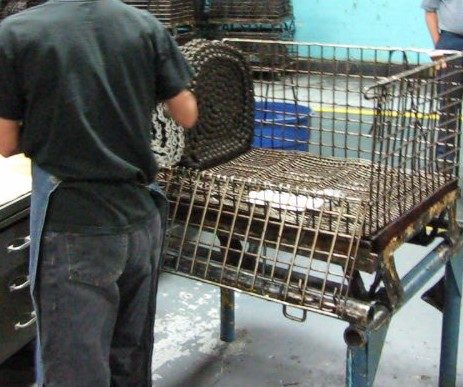 |
|
| Two styles of containers with drop down doors | |
It is common for containers to have doors that drop down or swing out. The wire basket (or cage) at left has one side that drops down. Furthermore, the basket is placed on a fixed height stand (see lifts) so that materials can be loaded and unloaded with minimal bending and reaching. The photo at right shows the equivalent feature on a plastic container. In this case, also note the conveyor and the cart (with a conveyor surface) which facilitates handling in several ways. (See conveyors and carts)
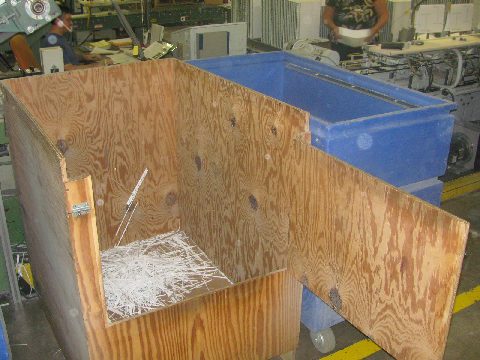 |
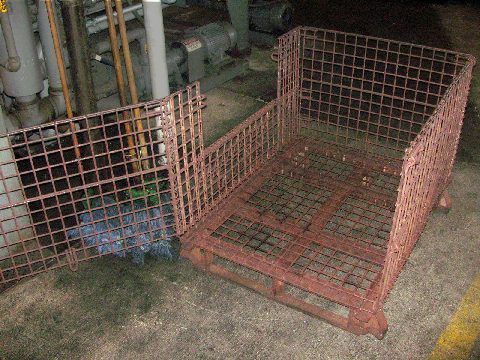 |
| Swing out door | Cage with both a swing-out door and a drop-down door |
The homemade plywood scrap container above has a swing-out door, and although it still requires some bending to clean out, it is better than the adjacent blue commercial container. (In this situation a dumper might be preferable.)
 |
 |
| Open | Closed |
Cardboard containers are available with cut sides that open for access. The cover helps secure the side when full.
Removable sides
 |
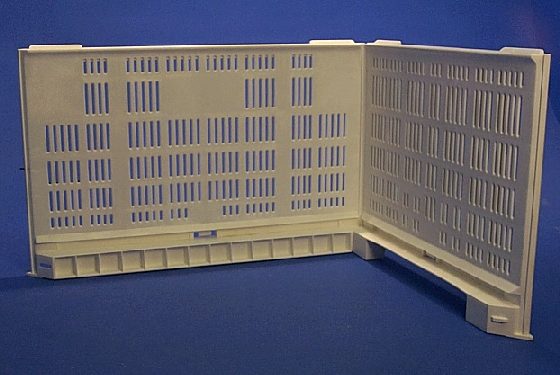 |
| One side removed | All sides can be removed for total access |
Some designs have sides that are completely removable, for total access from any direction (above www.pacificbin.com).
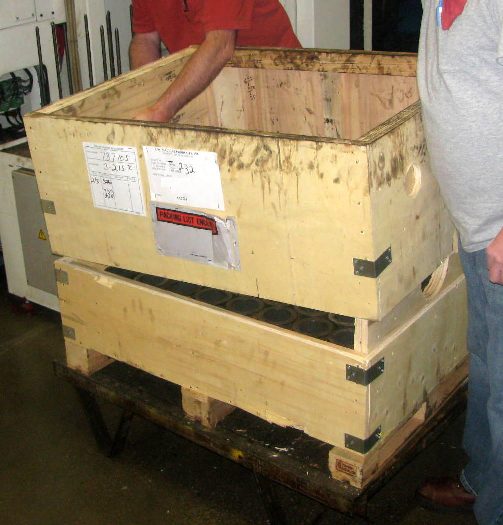 |
 |
| Removing upper portion of container | Materials in bottom portion are more accessible |
A different design has stackable, removable sections.
Spring-loaded bottoms
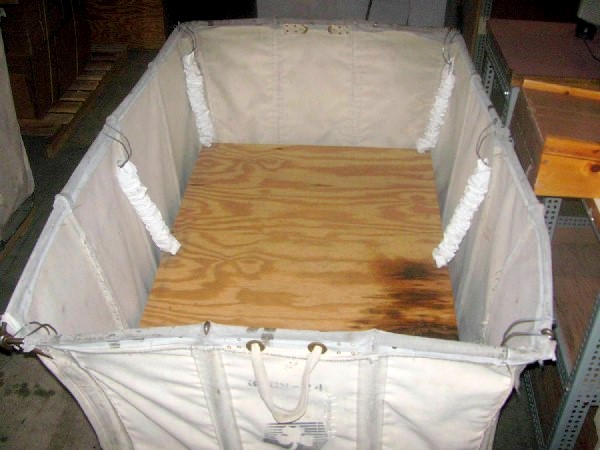 |
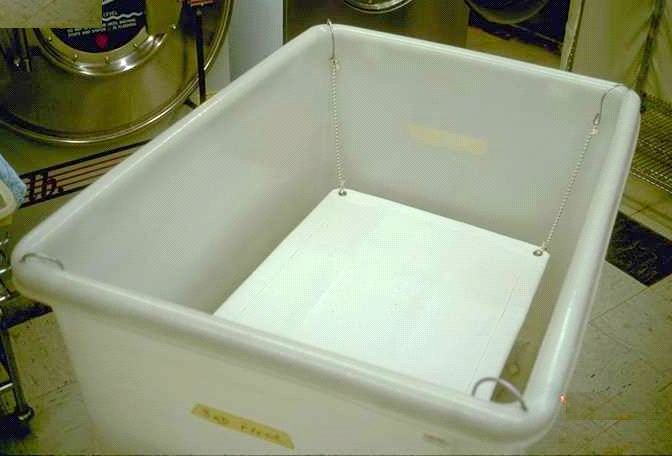 |
| Homemade retrofitted platforms and springs for hampers | |
A unique approach that is becoming common is adding springs and a platform to existing containers. Both photos above show very inexpensive homemade versions. The example above left shows a plywood platform and coil springs added to a canvas hamper in a manufacturing plant (the coil springs are wrapped to prevent items from getting caught in the springs). At right is a plastic laundry cart in a hospital where bungee cords were used to hold a rigid plastic sheet used as a false bottom.
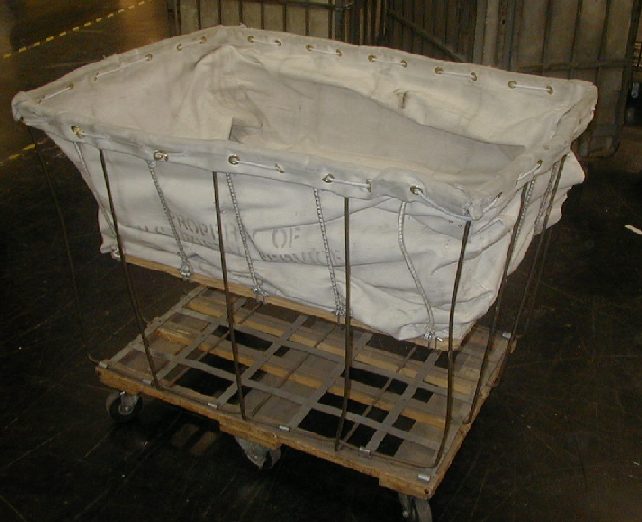 |
 |
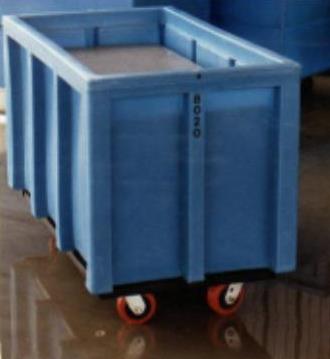 |
| External bungee cords on cloth hamper (www.postalproducts.com, a private company, not USPS itself) | Plastic container with suspended springs (www.MODLaundry.com) | Coil springs under false bottom (www.dpirotocarts.com) |
Commercially made products are also available. The US Postal Service has for years used canvas hampers with an external platform and bungee cords. Hospital laundries often use spring-loaded containers. The version at right uses coil springs under the platform. (See lifts for alternative types of spring-loaded lifting equipment.)
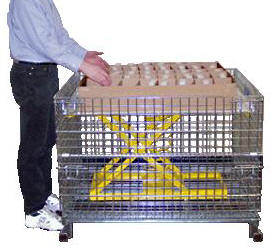 |
 |
| Small scissors lift inside basket (www.southworthproducts.com) | Spring-loaded platform inside basket (www.ergocart.com) |
Other types of lifts have recently become available that can be inserted into large container. This technology raises the items in the container to good working height, just as with standard lifts. Above left is a scissors lift and above right a coil spring unit is used
Switching to smaller containers
In line with the Lean Manufacturing concept of reducing WIP and lot sizes, it is possible to use smaller sized containers than have typically been used in the past. Smaller size generally involves less expensive, require less bending and reaching, and enables use of less expensive handling equipment.
Collapsible
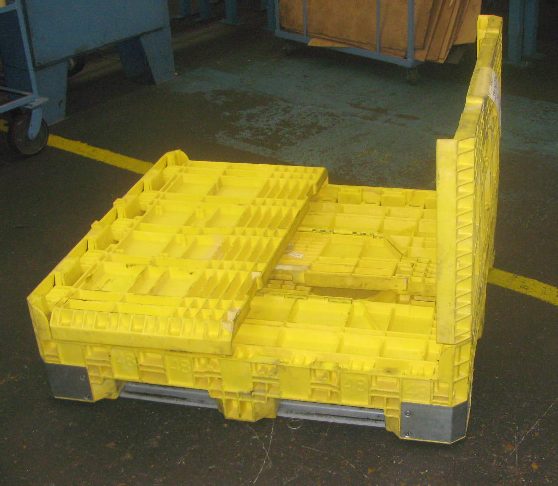 |
| Collapsible |
Many styles of containers are collapsible. The primary intent of this feature is to facilitate the return of the container, but it can makes handling easier as well.
